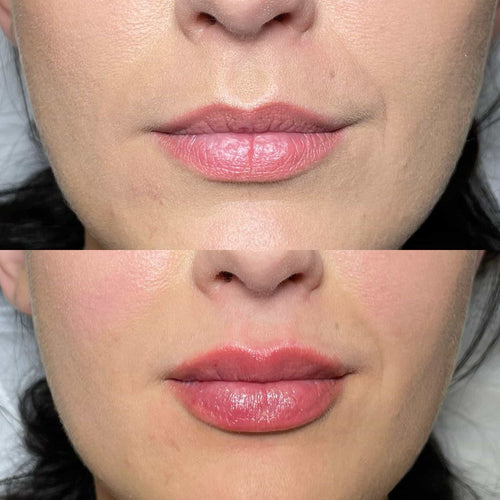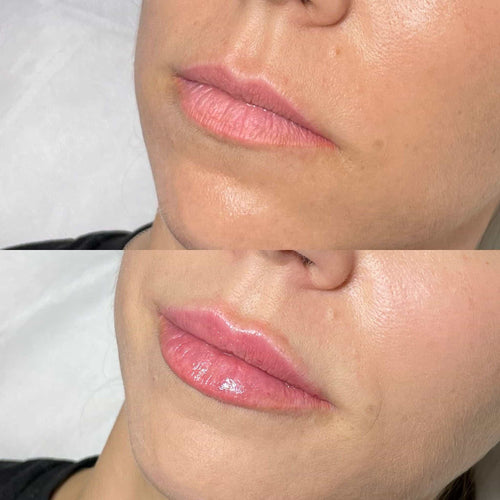Arrange Your Dermal Filler Consultation with Dr. Laura Geige
Duration of Temple Filler Results
The duration of temple filler results can vary from person to person, but on average, they typically last anywhere between 12 to 18 months.
This timeframe allows for noticeable changes in facial structure and appearance, as well as an improvement in skin texture and tone.
During the initial recovery period, which usually lasts around 2-3 weeks, temporary swelling and bruising may occur at the temple site, but these side effects are minimal and usually resolve on their own.
As the filler is fully absorbed by the body, the effects typically become more pronounced within 1-2 months, revealing a smoother, more youthful appearance.
Factors such as lifestyle choices, environmental conditions, and individual metabolism can influence the longevity of temple filler results. For instance:
Smoking and excessive sun exposure may cause faster absorption of the filler, reducing the duration of results.
A healthy diet rich in vitamins and antioxidants can help maintain optimal skin health and prolong the lifespan of the filler.
Frequent exercise and regular facial massage can also contribute to longer-lasting results by stimulating blood flow and promoting collagen production.
It’s essential to note that temple filler results may vary significantly from person to person, and individual outcomes are influenced by several factors, including:
Age: As we age, our skin undergoes natural changes that can affect the durability of the filler.
Filler type and brand: Different types and brands of fillers have varying levels of longevity, with some lasting longer than others.
Injection technique and experience: A skilled and experienced healthcare professional will ensure proper injection technique and placement to maximize results.
Proper aftercare and maintenance: Following post-treatment instructions carefully can help maintain optimal results and extend the lifespan of the filler.
A combination of these factors contributes to the average duration of temple filler results, which typically lasts 12-18 months before noticeable fading or absorption occurs.
The duration of temple filler results can vary depending on several factors, including individual responses to the treatment, lifestyle choices, and overall health conditions.
A well-received temple filler procedure typically leads to noticeable improvements in facial aesthetics for several months after treatment. The exact duration of results may range from 4 to 6 months, although some patients may experience optimal benefits for up to a year or more.
Several factors can influence the longevity of temple filler results, including:
- A person’s age: Generally, younger individuals tend to respond better to fillers and achieve longer-lasting results compared to older adults. This is due in part to decreased collagen breakdown over time.
Smokers may notice reduced filler longevity compared to non-smokers, likely due to the damaging effects of tobacco on blood vessels and skin health. Similarly, patients who spend extensive periods in the sun without adequate protection risk accelerated break-down of the filler material.
A healthy lifestyle, including regular exercise, a balanced diet, and proper skincare, can help extend the duration of temple filler results. Additionally, using sunscreen with at least SPF 30 and avoiding harsh products that strip the skin of its natural oils can contribute to longer-lasting fillers.
It is essential for individuals considering temple fillers to consult with a qualified medical professional to discuss their personal expectations and potential outcomes based on their individual circumstances.

Surgical Options for Extended Results
The duration of temple filler results can vary depending on several factors, including the type of filler used, individual metabolism, and lifestyle choices.
Aesthetic surgeons often recommend various surgical options to extend the results of temple fillers, reduce downtime, or provide more durable solutions for permanent results.
One common option is to use temporary implants made from biocompatible materials like Gore-Tex or Silastic. These implants are designed to be inserted under the skin and can help restore lost volume and contours in a temporary manner.
Temporary implants can last anywhere from 6 months to 2 years, depending on the individual’s healing process and lifestyle factors. They offer an excellent solution for patients who want to maintain their results without committing to permanent surgery.
Another option is to use reinforced filling materials like Sculptra or Radiesse. These fillers are designed to stimulate collagen production and can provide more durable results compared to temporary implants.
Sculptra, for example, uses poly-L-lactic acid (PLLA) to stimulate collagen growth, which can lead to more permanent results. This filler is often used in facial rejuvenation procedures, including temple fillers.
Radiesse, on the other hand, is a hyaluronic acid-based filler that combines calcium hydroxylapatite microspheres for added durability and support. The results of Radiesse can last up to 18 months, making it an excellent option for patients seeking long-term results.
For more permanent solutions, surgeons may recommend surgical options like fat transfer or bone grafting. Fat transfer involves transferring excess fat from one area of the body to the temple, while bone grafting uses bone tissue to restore lost volume and structure.
Fat transfer can provide natural-looking results that last for years, but it requires multiple sessions to achieve optimal results. Bone grafting, on the other hand, provides more structural support and can be used in conjunction with fillers for added durability.
Another surgical option is temporalis muscle fascia (TMF) flap harvesting, which involves transferring tissue from the temple area to restore lost volume. This procedure requires expertise and precision but offers exceptional results that can last for decades.
In some cases, a combination of surgical options may be used to achieve optimal results. For example, a patient may undergo fat transfer followed by bone grafting to ensure added durability and support.

It’s essential to consult with an experienced aesthetic surgeon to determine the best course of treatment for individual needs and goals. With careful planning and expert guidance, patients can enjoy extended results from temple fillers or temporary implants that last for years to come.
Ultimately, the choice between surgical options depends on factors like individual metabolism, lifestyle choices, and personal preferences. A thorough consultation with a board-certified surgeon will help patients make informed decisions about their facial rejuvenation treatment plan.
A well-planned treatment approach can ensure optimal results, minimize downtime, and provide long-term satisfaction for patients seeking temple filler or surgical options to extend results.
A variety of surgical options are available for those seeking extended results and potentially longer longevity with temple fillers.
Injections, such as hyaluronic acid fillers, calcium hydroxylapatite, or poly-L-lactic acid, can provide long-lasting results that last anywhere from 1 to 2 years, depending on individual factors.
The American Academy of Otolaryngology has conducted extensive research on the longevity of temple fillers, and their findings suggest that certain types of fillers may offer longer-lasting results than others.
For example, a study published in the Journal of Clinical Aesthetic Dermatology found that hyaluronic acid fillers lasted an average of 18 months, while calcium hydroxylapatite fillers lasted an average of 21 months.
On the other hand, poly-L-lactic acid fillers have been shown to provide results that can last up to 2 years or more in some cases, according to a study published in the Journal of Dermatological Surgery and Oncology.
The longevity of temple fillers also depends on various factors, including the individual’s overall health, lifestyle, and genetics.
For instance, individuals who smoke or have a history of skin cancer may experience shorter-lasting results with filler injections.
In contrast, those who lead healthy lifestyles, avoid smoking, and get regular sun protection may be more likely to experience longer-lasting results with their temple fillers.
Another factor that affects the longevity of temple fillers is the location and depth of the injection site.
Fillers injected into deeper layers of the skin tend to last longer than those injected into superficial layers.
The American Academy of Otolaryngology recommends using high-quality, FDA-approved fillers that have been extensively tested for safety and efficacy before undergoing any surgical procedure.
It’s also essential to follow post-operative instructions carefully to ensure optimal results and minimize the risk of complications.
Arrange a Dermal Filler Appointment with Dr. Laura Geige
Additional treatments, such as botulinum toxin injections or facial exercises, may also be recommended to enhance the longevity of temple fillers and maintain a more youthful appearance.
A comprehensive evaluation by an experienced healthcare professional is necessary to determine the most suitable surgical options for extended results and potentially longer longevity with temple fillers.
By understanding the potential benefits and risks associated with each type of filler, individuals can make informed decisions about their cosmetic treatments and achieve the desired outcomes.
In addition to surgical options, non-surgical procedures such as laser skin resurfacing or chemical peels may also be used in conjunction with temple fillers to enhance their longevity and promote overall facial rejuvenation.
Maintaining Temple Filler Results Over Time
To maintain temple filler results over time, it’s essential to follow a comprehensive aftercare routine recommended by a board-certified ear, nose, and throat (ENT) specialist.
The key to prolonged temple filler longevity lies in maintaining proper hydration levels, as this helps keep the filler material plump and hydrated from within. Drinking plenty of water throughout the day is crucial to prevent dryness and maintain optimal results.
Additionally, a consistent skincare routine is vital for temple fillers. Gentle cleansing with mild soap and lukewarm water can help remove dirt and bacteria without stripping the area of its natural oils. Avoid using harsh products containing exfoliating ingredients or astringents, as these can cause irritation and dryness.
Regular exercise, including facial yoga, is also beneficial for temple fillers. Gentle movements and expressions can help maintain blood flow and keep the filler material supple and hydrated. However, intense exercise or high-impact activities should be avoided to prevent trauma to the area.
Sleeping with a gentle pillow or using an orthotic device can help reduce pressure on the temples and minimize the risk of filler migration or loss over time. Elevating the head of the bed by 4-6 inches can also promote better drainage and prevent puffiness.
Regular follow-up appointments with a board-certified ENT specialist are crucial for maintaining temple filler results over time. A comprehensive evaluation can help identify any potential issues, such as filler migration or unevenness, which can be addressed promptly to ensure optimal outcomes.
A typical follow-up appointment may involve a thorough examination of the temples, including palpation and ultrasound imaging to assess the filler material’s distribution and density. The ENT specialist may also discuss lifestyle modifications, provide additional aftercare instructions, and offer advice on how to prevent common complications like bruising or swelling.
Furthermore, the use of topical treatments and serums can help promote collagen production and maintain temple filler results over time. A dermatologist-recommended product containing peptides, vitamin C, or hyaluronic acid can be applied regularly to enhance skin elasticity and firmness.
Avoiding strenuous activities like heavy lifting, bending, or straining for extended periods can also help prevent trauma to the temples and maintain optimal results. Engaging in stress-reducing techniques like meditation or deep breathing exercises can also help mitigate the effects of facial muscles tension on temple fillers.
Reserve a Dermal Filler Consultation with Dr. Laura Geige
Finally, it’s essential to note that individual results may vary depending on factors such as skin type, filler material choice, and overall health. Maintaining open communication with a board-certified ENT specialist can help address any concerns or issues that arise over time, ensuring optimal outcomes for temple fillers.
The effects of temple fillers, also known as temporalis muscle relaxants or masseter relaxants, can last for several months after treatment. These types of treatments are used to treat temporomandibular joint (TMJ) disorders, jaw pain, and tension headaches.
A study published in the Journal of Oral Rehabilitation found that temple fillers can provide relief from TMJ pain and dysfunction for up to 6-8 months after treatment.
The American Academy of Sleep Medicine recommends that individuals who have received temple fillers consider ongoing use of these treatments, as they may be necessary to maintain optimal results. In some cases, individuals may need to return for repeated injections to maintain the desired level of relief from symptoms.
It’s worth noting that individual results may vary depending on factors such as age, overall health, and severity of symptoms. Some people may experience longer-lasting results from temple fillers, while others may require more frequent treatments.
The National Institute on Deafness and Other Communication Disorders (NIDCD) recommends a comprehensive treatment plan that addresses not only the physical symptoms but also psychological factors that contribute to TMJ disorders. This may include regular follow-up appointments with a healthcare professional, stress management techniques, and lifestyle modifications such as avoiding certain foods or activities that exacerbate symptoms.
In terms of maintaining temple filler results over time, it’s essential to establish a long-term treatment plan with a qualified healthcare provider. Regular check-ups can help monitor the effectiveness of treatments and adjust dosages or treatment plans as needed.
The NIDCD also recommends considering alternative treatments for TMJ disorders, such as physical therapy, stress management techniques, or over-the-counter pain medications, which may be more cost-effective and less invasive than repeated temple filler injections.
Overall, while the effects of temple fillers can last for several months, ongoing maintenance treatment is necessary to ensure optimal results and prevent symptoms from returning.
It’s also worth noting that research in this area is ongoing, and new studies are continually exploring the effectiveness of various treatments for TMJ disorders. As a result, individuals seeking relief from these symptoms should consult with a qualified healthcare provider to determine the best course of treatment for their specific needs.
A comprehensive understanding of the treatment options available, including temple fillers, is essential for achieving optimal results and minimizing potential complications. By working with a qualified healthcare professional, individuals can develop a personalized treatment plan that addresses their unique symptoms and needs.
Read more about Reimagining Journalism here. Read more about Lace and Scotch here. Read more about Making Memories London here. Read more about Josie Barrett here. Read more about Apples and Pears Co. here.
- Nasolabial Fold Fillers – Marionette Lines Near Farleigh, Surrey - September 17, 2025
- Most Luxurious THC Beverages On The Market - September 15, 2025
- Lip Flip Treatment Near Shepperton, Surrey - September 12, 2025
